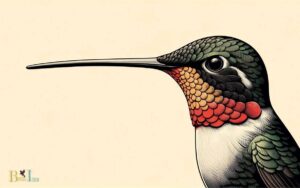Anna’s Hummingbird Territorial Behavior: Aerial Displays!
Anna’s Hummingbird, known for its vibrant plumage and dynamic flight patterns, exhibits strong territorial behavior, particularly during breeding seasons. Males aggressively defend their chosen areas to attract females and ensure ample food resources.
Territorial behavior in Anna’s Hummingbird is a critical aspect of their survival and breeding strategy. These birds are known for their iridescent feathers and rapid wingbeats, which allow them to hover in place while feeding.
During the breeding season, males establish territories that they defend fervently against rivals using a variety of tactics, including:
The primary reasons for this territorial behavior are to attract females for mating and to secure a reliable source of nectar, their main food source. A well-defended territory also provides a safe space for the female to build a nest and raise her young.
Anna’s Hummingbird’s territorial skirmishes, often seen as dazzling flashes of color clashing in midair, are a testament to the fierce competition these tiny birds face in their natural habitats.

Key Takeaway
Territorial Boundaries
Anna’s Hummingbirds vehemently defend their territorial boundaries against intruders. These boundaries are crucial for their survival and reproductive success.
Male Anna’s Hummingbirds establish and defend territories that contain resources necessary for attracting mates and sustaining themselves. These territories typically include a consistent supply of nectar-producing flowers and perches for surveillance.
The defense of these boundaries involves vigorous aerial chases, rapid dives, and vocal displays to deter intruders. Male hummingbirds perform impressive aerial displays, including fast and agile maneuvers to protect their territory.
These displays serve to communicate their ownership of the territory and warn intruders of the consequences of encroachment.
Understanding the behaviors associated with territorial defense provides valuable insights into the complex social dynamics and survival strategies of these remarkable birds.
Aerial Defense Tactics
Vehemently defending their established territories, male Anna’s Hummingbirds employ various aerial defense tactics to protect their resources and mating opportunities.
- Dive Bombing: The male hummingbird rapidly descends from a high point, emitting a sharp chirping sound to intimidate intruders.
- Mid-Air Maneuvers: Displaying remarkable agility, they engage in rapid twists, turns, and sudden direction changes to outmaneuver rivals.
- High-Speed Chases: They pursue intruders at astonishing speeds, utilizing their streamlined bodies and specialized flight muscles to swiftly cover ground.
- Feather Flaring: In confrontations, the Anna’s Hummingbird flares its iridescent throat feathers, creating a visually striking display to deter encroachment.
These tactics, honed through generations of evolutionary adaptation, effectively safeguard their coveted territories from encroachment by competing males.
Vocal Displays
Employing a combination of sharp chirping calls and complex vocal patterns, male Anna’s Hummingbirds adeptly utilize their vocal displays to assert dominance and defend their territories.
These displays are crucial in establishing and maintaining their territories, as well as attracting potential mates.
The table below provides a brief overview of the vocal displays exhibited by male Anna’s Hummingbirds.
| Vocal Display Type | Description | Purpose |
|---|---|---|
| Chirping Calls | Short, rapid, and high-pitched calls | Assert territorial dominance |
| Complex Vocal Patterns | Elaborate sequences of varied notes and rhythms | Attract potential mates |
| Trill Calls | Rapid, repetitive, and musical calls | Warn off intruders and defend territory |
These vocal displays not only serve as a means of communication but also play a significant role in the reproductive success of male Anna’s Hummingbirds.
Mating and Courtship Rituals
Male Anna’s Hummingbirds employ intricate mating and courtship rituals to attract potential mates and establish reproductive success.
The following behaviors are commonly observed during the mating and courtship rituals of Anna’s Hummingbirds:
- Dive Displays: Males perform impressive aerial dives, reaching speeds of up to 60 miles per hour, then abruptly ascend while producing a high-pitched sound to capture the attention of females.
- Perching Flights: Males engage in rapid side-to-side flights while perched near females, showcasing their agility and vibrant plumage to demonstrate their genetic fitness.
- Chase Interactions: Male hummingbirds engage in playful chases to exhibit their speed, agility, and territorial dominance to potential mates.
- Elaborate Feeding Displays: Males perform intricate aerial displays, diving in a U-shaped pattern in front of females, showcasing their stamina and resourcefulness as providers.
Human Interaction Impacts
Human interaction impacts on Anna’s Hummingbird territorial behavior have become increasingly evident in recent decades.
As urbanization continues to encroach upon natural habitats, human activities such as gardening, construction, and the presence of feeders are altering the behavior of these remarkable birds.
The table below summarizes the specific impacts of human interaction on Anna’s Hummingbird territorial behavior.
| Human Interaction | Impact on Territorial Behavior |
|---|---|
| Urbanization | Increased aggression towards conspecifics due to limited space |
| Gardening | Alteration of foraging patterns and resource competition |
| Construction | Disruption of nesting sites leading to territorial disputes |
| Presence of Feeders | Changes in movement patterns and increased defense of food sources |
| Noise Pollution | Heightened stress levels affecting territorial defense and courtship displays |
These interactions highlight the need for further research and conservation efforts to mitigate the impact of human activities on Anna’s Hummingbird behavior.
Conclusion
The territorial behavior of the Anna’s hummingbird is a complex and fascinating display of aerial defense tactics, vocal displays, and mating rituals. The bird’s dedication to defending its territory is as unwavering as a sentry standing guard at a fortress.
Understanding and respecting these behaviors is crucial for minimizing human impact on their natural habitats.






